The universe tells Voyager to get bent
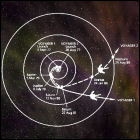 NASA’s Voyager 2 probe, having recently celebrated its 30th anniversary in deep space, sends back observations and instrument readings that lead scientists to a surprising conclusion: the “bubble” of the sun’s solar wind and magnetic influence isn’t spherical or even egg-shaped. Voyager 2′s readings, including the fact that it crossed what should’ve been the boundary of the sun’s outermost influence several times, have revealed that the solar system’s outermost boundary is in flux. Scientists theorize that the “dent” in that bubble is caused by the interstellar magnetic field of the Milky Way galaxy itself. Voyager 2 is now over 10 billion kilometers from the sun – or, to put that in perspective, 80 times further away from the sun than Earth is.
NASA’s Voyager 2 probe, having recently celebrated its 30th anniversary in deep space, sends back observations and instrument readings that lead scientists to a surprising conclusion: the “bubble” of the sun’s solar wind and magnetic influence isn’t spherical or even egg-shaped. Voyager 2′s readings, including the fact that it crossed what should’ve been the boundary of the sun’s outermost influence several times, have revealed that the solar system’s outermost boundary is in flux. Scientists theorize that the “dent” in that bubble is caused by the interstellar magnetic field of the Milky Way galaxy itself. Voyager 2 is now over 10 billion kilometers from the sun – or, to put that in perspective, 80 times further away from the sun than Earth is.
Kaguya at the Moon
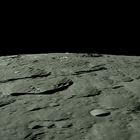 Japan’s unmanned Kaguya spacecraft, also known as SELENE, enters a polar orbit around Earth’s moon with an average altitude of 62 miles. Billed by Japanese space agency JAXA as the most significant lunar mission since the Apollo era, Kaguya carries numerous science experiments, though the public is most captivated by video transmitted back to Earth from two on-board HDTV cameras supplied by television network NHK. Kaguya conducts accurate gravitational mapping of the far side of the moon for the first time, and its own terrain camera obtains high-resolution mapping data, which will later be shared with Google for an online 3-D map of the moon.
Japan’s unmanned Kaguya spacecraft, also known as SELENE, enters a polar orbit around Earth’s moon with an average altitude of 62 miles. Billed by Japanese space agency JAXA as the most significant lunar mission since the Apollo era, Kaguya carries numerous science experiments, though the public is most captivated by video transmitted back to Earth from two on-board HDTV cameras supplied by television network NHK. Kaguya conducts accurate gravitational mapping of the far side of the moon for the first time, and its own terrain camera obtains high-resolution mapping data, which will later be shared with Google for an online 3-D map of the moon.
Asteroid explorer Dawn lifts off
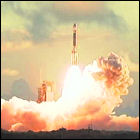 NASA launches the unmanned Dawn spacecraft, a vehicle designed to explore the two largest bodies in the asteroid belt between Mars and Jupiter. Dawn will also test a new charged ion propulsion system designed to improve on the performance of traditional chemical propellants (though its fine-tuning reaction control system will still use small engines powered by “rocket fuel”). Dawn is intended to visit and orbit the asteroid Vesta in 2011, which it will then depart after mapping to explore Ceres in 2015.
NASA launches the unmanned Dawn spacecraft, a vehicle designed to explore the two largest bodies in the asteroid belt between Mars and Jupiter. Dawn will also test a new charged ion propulsion system designed to improve on the performance of traditional chemical propellants (though its fine-tuning reaction control system will still use small engines powered by “rocket fuel”). Dawn is intended to visit and orbit the asteroid Vesta in 2011, which it will then depart after mapping to explore Ceres in 2015.
Kaguya lifts off
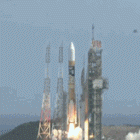 The Japanese space agency, JAXA, launches the unmanned SELENE (Selenological and Engineering Explorer) spacecraft to orbit Earth’s moon. SELENE is nicknamed Kaguya after a princess of the moon from Japanese folklore. Kaguya is scheduled to enter a polar lunar orbit in October, where it will conduct experiments in spectography, radio science, and charged particle and gamma ray detection. Though Kaguya has an on-board camera to map lunar terrain, the views for which it will become most famous will be shot by two HDTV cameras supplied by Japanese television network NHK, providing spectacular views of the lunar surface as they would be seen by an orbiting explorer.
The Japanese space agency, JAXA, launches the unmanned SELENE (Selenological and Engineering Explorer) spacecraft to orbit Earth’s moon. SELENE is nicknamed Kaguya after a princess of the moon from Japanese folklore. Kaguya is scheduled to enter a polar lunar orbit in October, where it will conduct experiments in spectography, radio science, and charged particle and gamma ray detection. Though Kaguya has an on-board camera to map lunar terrain, the views for which it will become most famous will be shot by two HDTV cameras supplied by Japanese television network NHK, providing spectacular views of the lunar surface as they would be seen by an orbiting explorer.
NASA rethinks Dawn cancellation
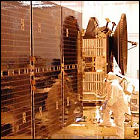 NASA reverses a decision made earlier in the month to cancel the asteroid-hopping Dawn mission, following appeals and assurances from the mission managers. Intended to use ion propulsion to visit to of the asteroid belt’s largest bodies, Dawn’s cancellation does have the effect of sliding the mission from a 2006 launch to a 2007 launch. The budget for the mission is expanded from $373,000,000 to $446,000,000, and arrival at its first target, the large asteroid Vesta, is still scheduled for 2011.
NASA reverses a decision made earlier in the month to cancel the asteroid-hopping Dawn mission, following appeals and assurances from the mission managers. Intended to use ion propulsion to visit to of the asteroid belt’s largest bodies, Dawn’s cancellation does have the effect of sliding the mission from a 2006 launch to a 2007 launch. The budget for the mission is expanded from $373,000,000 to $446,000,000, and arrival at its first target, the large asteroid Vesta, is still scheduled for 2011.
New Horizons at Jupiter
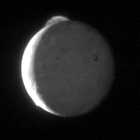 NASA’s New Horizons probe, on a one-way trip to become the first probe to swing past distant Pluto, picks up speed dramatically as it slingshots past Jupiter. New Horizons sensors are trained on the giant planet to get the first look at Jupiter since Galileo swan-dived into its crushing atmosphere. New Horizons gains nearly 9,000 miles per hour as it swings past Jupiter, which will put it at Pluto in July 2015. New Horizons’ camera catches an erupting volcano on Jupiter’s moon Io, spewing material 200 miles above the surface.
NASA’s New Horizons probe, on a one-way trip to become the first probe to swing past distant Pluto, picks up speed dramatically as it slingshots past Jupiter. New Horizons sensors are trained on the giant planet to get the first look at Jupiter since Galileo swan-dived into its crushing atmosphere. New Horizons gains nearly 9,000 miles per hour as it swings past Jupiter, which will put it at Pluto in July 2015. New Horizons’ camera catches an erupting volcano on Jupiter’s moon Io, spewing material 200 miles above the surface.
Rosetta at Mars
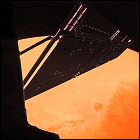 ESA’s unmanned Rosetta space probe, carrying the Philae lander bound for a 2014 rendezvous with Comet 67/P Churyumov–Gerasimenko, makes a gravity-assist flyby of planet Mars to alter its trajectory. As Rosetta will be only 160 miles from the Martian surface at its closest approach, the spacecraft is put into a safe mode for this critical part of its trip, and emerges unscathed. Its next gravity assist will come from Earth itself later in the year.
ESA’s unmanned Rosetta space probe, carrying the Philae lander bound for a 2014 rendezvous with Comet 67/P Churyumov–Gerasimenko, makes a gravity-assist flyby of planet Mars to alter its trajectory. As Rosetta will be only 160 miles from the Martian surface at its closest approach, the spacecraft is put into a safe mode for this critical part of its trip, and emerges unscathed. Its next gravity assist will come from Earth itself later in the year.
My own private space station: Genesis I
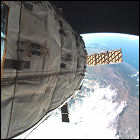 A scaled-down proof-of-concept model of an inflatible space station module designed by NASA in the 1990s, Genesis I is launched (with no occupants, or, indeed, an airlock to allow access) by Las Vegas-based Bigelow Aerospace. Genesis I is a testbed for a privately-operated space station whose pressurized modules (inflated from within by the supply of breathable air) would be much cheaper to launch than pre-fabricated structures such as the International Space Station. With several cameras monitoring every angle of the station, the module fully inflates in just ten minutes.
A scaled-down proof-of-concept model of an inflatible space station module designed by NASA in the 1990s, Genesis I is launched (with no occupants, or, indeed, an airlock to allow access) by Las Vegas-based Bigelow Aerospace. Genesis I is a testbed for a privately-operated space station whose pressurized modules (inflated from within by the supply of breathable air) would be much cheaper to launch than pre-fabricated structures such as the International Space Station. With several cameras monitoring every angle of the station, the module fully inflates in just ten minutes.
GOES-13 goes up
 NOAA’s GOES-13 Geostationary Operational Environmental Satellite is launched from Cape Canaveral into geosynchronous orbit to monitor weather patterns over the United States. It will be held in reserve until 2010, when it will be moved to the GOES-EAST position to replace GOES-12, which is suffering chronic attitude control thruster glitches. GOES-13 is yet another evolutionary step up in the GOES satellite hardware, but it will suffer its own share of hardware issues, including a series of inexplicable faults which will cause brief losses of weather coverage, and a later fault which disables infrared imaging capability. Some of these hardware failures will be attributed to micrometeoroid collisions.
NOAA’s GOES-13 Geostationary Operational Environmental Satellite is launched from Cape Canaveral into geosynchronous orbit to monitor weather patterns over the United States. It will be held in reserve until 2010, when it will be moved to the GOES-EAST position to replace GOES-12, which is suffering chronic attitude control thruster glitches. GOES-13 is yet another evolutionary step up in the GOES satellite hardware, but it will suffer its own share of hardware issues, including a series of inexplicable faults which will cause brief losses of weather coverage, and a later fault which disables infrared imaging capability. Some of these hardware failures will be attributed to micrometeoroid collisions.
Venus Express arrives
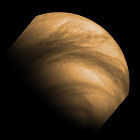 The European Space Agency’s Venus Express space probe – the first unmanned spacecraft to closely examine the second planet from the sun since the late 1970s – arrives at the planet to undertake a detailed study of the atmosphere, the unusually symmetrical cloud patterns of the planet’s north and south hemispheres, as well as observing the massive, hurricane-like vortices which remain over the poles. Venus Express also looks for the source of traces of sulphur dioxide in the Venusian atmosphere, which could be a sign that of active volcanoes on the surface.
The European Space Agency’s Venus Express space probe – the first unmanned spacecraft to closely examine the second planet from the sun since the late 1970s – arrives at the planet to undertake a detailed study of the atmosphere, the unusually symmetrical cloud patterns of the planet’s north and south hemispheres, as well as observing the massive, hurricane-like vortices which remain over the poles. Venus Express also looks for the source of traces of sulphur dioxide in the Venusian atmosphere, which could be a sign that of active volcanoes on the surface.
NASA’s Dawn mission cancelled
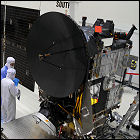 Having been “on hold” since October 2005 pending an audit of technical and managerial issues related to the mission, NASA formally cancels the Dawn unmanned mission to the asteroid belt. The spacecraft had been intended to lift off in 2006, using an ion propulsion system to visit, orbit, and map not one, but two, of the largest bodies in the asteroid belt between Mars and Jupiter, in the following decade. The mission is cancelled when NASA auditors find unresolved technical issues and project a budget overrun of 20%. Planners and managers for the Dawn mission plan to appeal NASA’s decision.
Having been “on hold” since October 2005 pending an audit of technical and managerial issues related to the mission, NASA formally cancels the Dawn unmanned mission to the asteroid belt. The spacecraft had been intended to lift off in 2006, using an ion propulsion system to visit, orbit, and map not one, but two, of the largest bodies in the asteroid belt between Mars and Jupiter, in the following decade. The mission is cancelled when NASA auditors find unresolved technical issues and project a budget overrun of 20%. Planners and managers for the Dawn mission plan to appeal NASA’s decision.
New Horizons launched
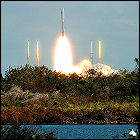 NASA launches the unmanned New Horizons probe on a course for the minor planet Pluto, the first spacecraft built to explore that destination. A trajectory with multiple planetary flybys and gravitational assists is designed to sling New Horizons toward Pluto within a decade (compared to Voyager 2’s 12-year trek to Neptune).
NASA launches the unmanned New Horizons probe on a course for the minor planet Pluto, the first spacecraft built to explore that destination. A trajectory with multiple planetary flybys and gravitational assists is designed to sling New Horizons toward Pluto within a decade (compared to Voyager 2’s 12-year trek to Neptune).
New Horizons will enter Pluto’s surprisingly complex system in 2015.
Stardust comes home
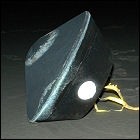 NASA’s unmanned Stardust space probe successfully returns its samples of comet and interstellar dust to Earth. A few minutes after 5:00am Eastern time, the Stardust sample return capsule makes a soft landing in Utah, its record-setting 29,000mph return to Earth slowed by a series of parachutes. (Before Stardust’s return, the fastest vehicle to enter Earth’s atmosphere was the capsule bringing home the crew of Apollo 10 in May 1969.) It is hoped that analysis of the tiny particles captured in cakes of a special porous material called aerogel will shed some light on the origins of the solar system. The “mother ship” portion of the Stardust probe is left on a course that will put it into a permanent orbit around the sun. Stardust was launched in February 1999, and gathered its samples from the cloud of gas and dust surrounding Comet Wild-2 in January 2004, zipping through the comet’s coma at 13,000mph.
NASA’s unmanned Stardust space probe successfully returns its samples of comet and interstellar dust to Earth. A few minutes after 5:00am Eastern time, the Stardust sample return capsule makes a soft landing in Utah, its record-setting 29,000mph return to Earth slowed by a series of parachutes. (Before Stardust’s return, the fastest vehicle to enter Earth’s atmosphere was the capsule bringing home the crew of Apollo 10 in May 1969.) It is hoped that analysis of the tiny particles captured in cakes of a special porous material called aerogel will shed some light on the origins of the solar system. The “mother ship” portion of the Stardust probe is left on a course that will put it into a permanent orbit around the sun. Stardust was launched in February 1999, and gathered its samples from the cloud of gas and dust surrounding Comet Wild-2 in January 2004, zipping through the comet’s coma at 13,000mph.
Homeward, Hayabusa!
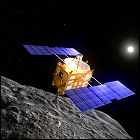 JAXA’s unmanned Hayabusa spacecraft fires its ion engines to depart asteroid 25143 Itokawa, embarking on a five-year trek back to Earth to return surface samples it obtained of the asteroid. Hayabusa has experienced numerous technical glitches, and continues to experience further problems, including a total loss of contact with Earth for several weeks. Only two out of the vehicle’s four ion engines are still functional, and its battery system is only partially reliable, but it is carrying its precious cargo of the first sample material from an asteroid back to Earth.
JAXA’s unmanned Hayabusa spacecraft fires its ion engines to depart asteroid 25143 Itokawa, embarking on a five-year trek back to Earth to return surface samples it obtained of the asteroid. Hayabusa has experienced numerous technical glitches, and continues to experience further problems, including a total loss of contact with Earth for several weeks. Only two out of the vehicle’s four ion engines are still functional, and its battery system is only partially reliable, but it is carrying its precious cargo of the first sample material from an asteroid back to Earth.
Hayabusa on Itokawa
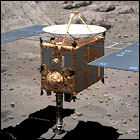 A second attempt is made by the Japanese Aerospace Exploration Agency to bring its unmanned space probe, Hayabusa, close enough to gather a sample of surface material from asteroid 25143 Itokawa. It attempts to deploy a mini-rover called Minerva to explore Itokawa from the surface, but a glitch results in a trajectory that leaves Minerva tumbling into space, never to reach Itokawa. Hayabusa lands on Itokawa’s surface itself, though mission controllers don’t realize this for several more days. Contact is lost with Hayabusa for a short while, and when it is regained, the vehicle has left the surface and gone into safe mode.
A second attempt is made by the Japanese Aerospace Exploration Agency to bring its unmanned space probe, Hayabusa, close enough to gather a sample of surface material from asteroid 25143 Itokawa. It attempts to deploy a mini-rover called Minerva to explore Itokawa from the surface, but a glitch results in a trajectory that leaves Minerva tumbling into space, never to reach Itokawa. Hayabusa lands on Itokawa’s surface itself, though mission controllers don’t realize this for several more days. Contact is lost with Hayabusa for a short while, and when it is regained, the vehicle has left the surface and gone into safe mode.
Hayabusa pulls up
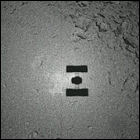 The first attempt to maneuver the unmanned space probe Hayabusa close enough to scoop up a sample of material from the surface of asteroid 25143 Itokawa is aborted by ground controllers at the Japanese space agency, JAXA. The spacecraft’s navigational system finds it difficult to maintain a precise lock on the elongated asteroid, so its automatic safety systems abort the approach to preserve Hayabusa intact. Another attempt to bring Hayabusa close enough to gather material from Itokawa’s surface will be made a week later.
The first attempt to maneuver the unmanned space probe Hayabusa close enough to scoop up a sample of material from the surface of asteroid 25143 Itokawa is aborted by ground controllers at the Japanese space agency, JAXA. The spacecraft’s navigational system finds it difficult to maintain a precise lock on the elongated asteroid, so its automatic safety systems abort the approach to preserve Hayabusa intact. Another attempt to bring Hayabusa close enough to gather material from Itokawa’s surface will be made a week later.
Hayabusa at Itokawa
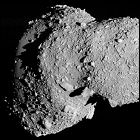 The Japanese unmanned space probe Hayabusa arrives at its destination, asteroid 25143 Itokawa, from which it will gather a sample of material for return to Earth and attempt to deploy a mini-rover. Hayabusa settles into an orbit around the sun parallel to Itokawa, rather than orbiting the asteroid itself, and maintains an initial distance of roughly 12 miles.
The Japanese unmanned space probe Hayabusa arrives at its destination, asteroid 25143 Itokawa, from which it will gather a sample of material for return to Earth and attempt to deploy a mini-rover. Hayabusa settles into an orbit around the sun parallel to Itokawa, rather than orbiting the asteroid itself, and maintains an initial distance of roughly 12 miles.
Colliding with Deep Impact
 After months on a precise interception course, NASA’s unmanned Deep Impact space probe meets up with Comet Tempel 1, firing a impactor into the comet’s nucleus to study the distribution and composition of the debris scattered by the resulting impact. The impactor had been released by the flyby spacecraft six days earlier, and transmitted its images and readings to the flyby vehicle, which records them and retransmits them to ground controllers on Earth. The two vehicles’ on-board software tracks the comet so precisely that the impact happens within a second of the anticipated timeline in the mission plan, kicking up enough cometary dust to obscure the view of the crater left on the comet’s nucleus. Following the Tempel 1 mission, the still-intact Deep Impact flyby vehicle is redirected for future missions to other objects in the solar system.
After months on a precise interception course, NASA’s unmanned Deep Impact space probe meets up with Comet Tempel 1, firing a impactor into the comet’s nucleus to study the distribution and composition of the debris scattered by the resulting impact. The impactor had been released by the flyby spacecraft six days earlier, and transmitted its images and readings to the flyby vehicle, which records them and retransmits them to ground controllers on Earth. The two vehicles’ on-board software tracks the comet so precisely that the impact happens within a second of the anticipated timeline in the mission plan, kicking up enough cometary dust to obscure the view of the crater left on the comet’s nucleus. Following the Tempel 1 mission, the still-intact Deep Impact flyby vehicle is redirected for future missions to other objects in the solar system.
Huygens: first space probe to land on Titan
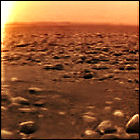 The European Space Agency’s Huygens probe successfully lands on Saturn’s largest moon, Titan, gathering measurements and taking mind-boggling images from the sky all the way down to the surface. Perhaps the biggest discovery of the initial pictures is an aerial view of what appear to be tributaries leading to a large body of liquid – an almost delta-like region as viewed from the sky. (Thanks to Titan’s thick atmospheric haze, its surface has never before been seen.) Huygens itself manages to touch down on dry land, on a plain scattered with chunks of ice, slowed to only 15 miles per hour by parachutes during its descent (despite upper-level winds estimated at around 300mph). Even if Huygens had splashed down in a body of liquid, the probe is designed to stay afloat.
The European Space Agency’s Huygens probe successfully lands on Saturn’s largest moon, Titan, gathering measurements and taking mind-boggling images from the sky all the way down to the surface. Perhaps the biggest discovery of the initial pictures is an aerial view of what appear to be tributaries leading to a large body of liquid – an almost delta-like region as viewed from the sky. (Thanks to Titan’s thick atmospheric haze, its surface has never before been seen.) Huygens itself manages to touch down on dry land, on a plain scattered with chunks of ice, slowed to only 15 miles per hour by parachutes during its descent (despite upper-level winds estimated at around 300mph). Even if Huygens had splashed down in a body of liquid, the probe is designed to stay afloat.
Launching Deep Impact
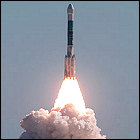 After months of delays in development of its elaborate guidance software system, NASA’s Deep Impact unmanned space probe is launched on a mission to intercept, and fire an impactor into, Comet Tempel 1 half a year later. In order to catch up with the comet, Deep Impact is lofted into orbit by a Delta II rocket, which puts the spacecraft on a precise course at a speed of roughly 64,000mph. Deep Impact will fire the impactor into the comet in July to study the distribution and composition of the debris scattered by the resulting impact.
After months of delays in development of its elaborate guidance software system, NASA’s Deep Impact unmanned space probe is launched on a mission to intercept, and fire an impactor into, Comet Tempel 1 half a year later. In order to catch up with the comet, Deep Impact is lofted into orbit by a Delta II rocket, which puts the spacecraft on a precise course at a speed of roughly 64,000mph. Deep Impact will fire the impactor into the comet in July to study the distribution and composition of the debris scattered by the resulting impact.
Voyager 2 at 10000
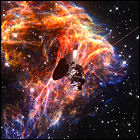 Launched ahead of its identical twin, Voyager 1, in 1977, NASA’s Voyager 2 spacecraft surpasses its 10,000th day in deep space. At 11 billion miles from Earth, Voyager 2 is one of the most distant human-made objects in space, surpassed only by Voyager 1. Both Voyagers are expected to function well into the 2020s, and are expected to have left the solar system to enter interstellar space by then.
Launched ahead of its identical twin, Voyager 1, in 1977, NASA’s Voyager 2 spacecraft surpasses its 10,000th day in deep space. At 11 billion miles from Earth, Voyager 2 is one of the most distant human-made objects in space, surpassed only by Voyager 1. Both Voyagers are expected to function well into the 2020s, and are expected to have left the solar system to enter interstellar space by then.
Swift Observatory launched
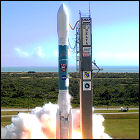 NASA successfully launches the Swift unmanned deep space observatory after a small delay. Carrying three different instrument packages, Swift’s mission is specifically to observe, categorize and study the aftereffects of gamma ray bursts. The satellite is designed to aim itself at any such bursts that it detects within mere seconds so it can catch the short-lived aftereffects and relay its findings to ground controllers. It is believed that some of the bursts are caused by the dying collapse of stars, and possibly the formation of black holes, and as such may be some of the most powerful energy releases known in nature. Swift is expected to observe as many as 100 gamma ray bursts per year.
NASA successfully launches the Swift unmanned deep space observatory after a small delay. Carrying three different instrument packages, Swift’s mission is specifically to observe, categorize and study the aftereffects of gamma ray bursts. The satellite is designed to aim itself at any such bursts that it detects within mere seconds so it can catch the short-lived aftereffects and relay its findings to ground controllers. It is believed that some of the bursts are caused by the dying collapse of stars, and possibly the formation of black holes, and as such may be some of the most powerful energy releases known in nature. Swift is expected to observe as many as 100 gamma ray bursts per year.
Cassini and the ice volcanoes of Titan!
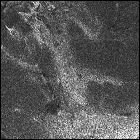 A billion miles from the sun, you don’t need molten lava for volcanoes – you just need subsurface ice to warm up and erupt as water. That’s what NASA scientists think they’ve spotted in a radar image of the surface of Saturn’s moon Titan sent back in late October by the Cassini unmanned probe. A bright, flow-like feature may be indicative of something oozing out onto Titan’s surface from below – and at the frigid temperatures experienced in Saturn’s orbit, ice volcanoes are more likely than the molten rock variety seen on Earth and Mars. If confirmed, this wouldn’t be the first “ice volcano” found in our solar system; Voyager 2 had already spotted an eruption on the surface of Neptune’s largest moon, Triton, as it swung by in August 1989.
A billion miles from the sun, you don’t need molten lava for volcanoes – you just need subsurface ice to warm up and erupt as water. That’s what NASA scientists think they’ve spotted in a radar image of the surface of Saturn’s moon Titan sent back in late October by the Cassini unmanned probe. A bright, flow-like feature may be indicative of something oozing out onto Titan’s surface from below – and at the frigid temperatures experienced in Saturn’s orbit, ice volcanoes are more likely than the molten rock variety seen on Earth and Mars. If confirmed, this wouldn’t be the first “ice volcano” found in our solar system; Voyager 2 had already spotted an eruption on the surface of Neptune’s largest moon, Triton, as it swung by in August 1989.
Cassini peers through Titan’s clouds
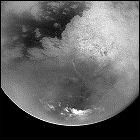 In its first close flyby of Saturn’s largest moon, the unmanned Cassini probe performs the first-ever radar reconaissance of Titan’s surface. Shrouded by a thick, organically-rich atmosphere, Titan’s surface has never been seen until now. Though scientists say that Cassini’s close pass only allows them to map 1% of the surface, the preliminary results prove to be fascinating. Titan seems, at first glance, to have a relatively smooth surface, perhaps indicating oceans, or ongoing glacial or volcanic resurfacing; a member of the radar imaging team says that readings have also indicated that the surface of Titan is “covered in organics.” Cassini will get further chances to aim its radar beams at Titan, and in December it will release the European Space Agency’s Huygens probe, which will approach Titan, ultimately entering the moon’s dense atmosphere in January to take direct readings from the surface, whether it’s solid or liquid.
In its first close flyby of Saturn’s largest moon, the unmanned Cassini probe performs the first-ever radar reconaissance of Titan’s surface. Shrouded by a thick, organically-rich atmosphere, Titan’s surface has never been seen until now. Though scientists say that Cassini’s close pass only allows them to map 1% of the surface, the preliminary results prove to be fascinating. Titan seems, at first glance, to have a relatively smooth surface, perhaps indicating oceans, or ongoing glacial or volcanic resurfacing; a member of the radar imaging team says that readings have also indicated that the surface of Titan is “covered in organics.” Cassini will get further chances to aim its radar beams at Titan, and in December it will release the European Space Agency’s Huygens probe, which will approach Titan, ultimately entering the moon’s dense atmosphere in January to take direct readings from the surface, whether it’s solid or liquid.
Possible cause of Genesis crash found
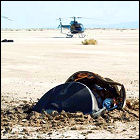 A week after the Genesis sample return mission tumbled back to Earth, slamming into the Utah desert floor at nearly 200 miles per hour after its parachutes failed to open, investigators find a likely cause of the crash. It appears that four gravity-sensitive switches, designed to sense the sudden deceleration of the Genesis capsule through Earth’s atmosphere and set off a timed sequence that would’ve opened the parachutes, had all been installed backwards. The four switches were designed to be redundant, so that if some failed the others could still carry out their assigned task…but this doesn’t do a lot of good if all of them are all installed incorrrectly. The investigation indicates that an erroneous schematic diagram of Genesis may be to blame. In the meantime, researchers begin to examine the surviving chunks of the broken collector plates containing particles of solar material.
A week after the Genesis sample return mission tumbled back to Earth, slamming into the Utah desert floor at nearly 200 miles per hour after its parachutes failed to open, investigators find a likely cause of the crash. It appears that four gravity-sensitive switches, designed to sense the sudden deceleration of the Genesis capsule through Earth’s atmosphere and set off a timed sequence that would’ve opened the parachutes, had all been installed backwards. The four switches were designed to be redundant, so that if some failed the others could still carry out their assigned task…but this doesn’t do a lot of good if all of them are all installed incorrrectly. The investigation indicates that an erroneous schematic diagram of Genesis may be to blame. In the meantime, researchers begin to examine the surviving chunks of the broken collector plates containing particles of solar material.
In too deep: Genesis’ disastrous landing
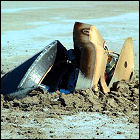 The NASA/JPL Genesis mission, a 29-month trek through the solar system to gather solar particles and return them to Earth, ends in disaster when both of the parachutes – meant to slow the returning Genesis capsule down and give retrieval helicopters something to hook onto to bring the capsule to the ground safely – fail to open. As a result, the 420+ pound Genesis capsule slams into the Utah desert floor at nearly 200 miles per hour. The impact breaches not only the outer re-entry shell of the capsule, but the experiment canister within containing the fragile plates of gold, sapphire, diamond and other pure substances, all of which had been exposed to the solar wind to collect particles from the sun. Scientists begin picking through the debris to see what portions of those collection devices can be salvaged. Several pieces of the collection devices are salvageable, with at least two complete plates and fragments of several others, but many other plates are reduced to dust by the impact of landing.
The NASA/JPL Genesis mission, a 29-month trek through the solar system to gather solar particles and return them to Earth, ends in disaster when both of the parachutes – meant to slow the returning Genesis capsule down and give retrieval helicopters something to hook onto to bring the capsule to the ground safely – fail to open. As a result, the 420+ pound Genesis capsule slams into the Utah desert floor at nearly 200 miles per hour. The impact breaches not only the outer re-entry shell of the capsule, but the experiment canister within containing the fragile plates of gold, sapphire, diamond and other pure substances, all of which had been exposed to the solar wind to collect particles from the sun. Scientists begin picking through the debris to see what portions of those collection devices can be salvaged. Several pieces of the collection devices are salvageable, with at least two complete plates and fragments of several others, but many other plates are reduced to dust by the impact of landing.
Cassini gets mooned at Saturn
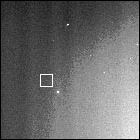 Mere weeks after entering orbit around the huge ringed planet, the Cassini is already making impressive discoveries at Saturn. NASA announces that Cassini images have uncovered two previously undiscovered moons in orbit of the ringed planet, and they’re among the smallest bodies that have yet been detected in space, each barely 2 miles in diameter. They’re given the provisional names s/2004 S1 and s/2004 S2, and await further verification of their size and orbits – and undoubtedly other members of Saturn’s family are waiting to be captured by Cassini’s cameras in the course of its planned four-year survey of the planet and its moons.
Mere weeks after entering orbit around the huge ringed planet, the Cassini is already making impressive discoveries at Saturn. NASA announces that Cassini images have uncovered two previously undiscovered moons in orbit of the ringed planet, and they’re among the smallest bodies that have yet been detected in space, each barely 2 miles in diameter. They’re given the provisional names s/2004 S1 and s/2004 S2, and await further verification of their size and orbits – and undoubtedly other members of Saturn’s family are waiting to be captured by Cassini’s cameras in the course of its planned four-year survey of the planet and its moons.
Cassini arrives at Saturn
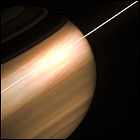 After a journey of seven years, gravity-assist slingshots past Earth, Venus and Jupiter, a plunge through Saturn’s ring-plane, and an engine burn of over an hour just to slow it down, the NASA/ESA space probe Cassini becomes the first man-made object to orbit Saturn. The trip has already paid off: Cassini has spotted never-before-seen features in Saturn’s immense rings, and succeeds in piercing Titan’s atmosphere with infrared imaging to provide one of the first-ever glimpses of the huge moon’s cloud-covered surface. Titan will also receive a visit from Cassini’s Huygens probe in 2005.
After a journey of seven years, gravity-assist slingshots past Earth, Venus and Jupiter, a plunge through Saturn’s ring-plane, and an engine burn of over an hour just to slow it down, the NASA/ESA space probe Cassini becomes the first man-made object to orbit Saturn. The trip has already paid off: Cassini has spotted never-before-seen features in Saturn’s immense rings, and succeeds in piercing Titan’s atmosphere with infrared imaging to provide one of the first-ever glimpses of the huge moon’s cloud-covered surface. Titan will also receive a visit from Cassini’s Huygens probe in 2005.
Mars Rovers’ mission extended
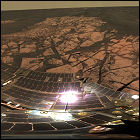 NASA announces that the Spirit rover has exceeded its mission goals of 90 continuous Martian days of operation since landing, with over 600 meters of the Martian surface covered. NASA applies for, and receives approval on, a plan to keep Spirit and Opportunity roving through September, almost tripling the rovers’ planned life span. The extended mission, made possible by a budget boost of $15 million, will give engineers the chance to try handing control over to the Rovers’ built-in systems, and it’ll afford a greater opportunity to examine the unusual rocks and evidence of past bodies of water on the Martian surface.
NASA announces that the Spirit rover has exceeded its mission goals of 90 continuous Martian days of operation since landing, with over 600 meters of the Martian surface covered. NASA applies for, and receives approval on, a plan to keep Spirit and Opportunity roving through September, almost tripling the rovers’ planned life span. The extended mission, made possible by a budget boost of $15 million, will give engineers the chance to try handing control over to the Rovers’ built-in systems, and it’ll afford a greater opportunity to examine the unusual rocks and evidence of past bodies of water on the Martian surface.
Not just water, but salt water, on Mars
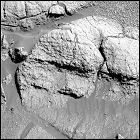 NASA scientists unveil new findings from the two Mars Exploration Rovers, Spirit and Opportunity. While both rovers have found evidence of water erosion in rocks at their respective landing sites, the scientists now say that Opportunity’s landing site – a large crater – features rocks which show conclusive evidence of a large body of salt water, not unlike Earth’s oceans. While no definitive signs of life have been found by Opportunity or its identical twin, these findings continue to add up to a picture of Mars as a place where life once could have thrived.
NASA scientists unveil new findings from the two Mars Exploration Rovers, Spirit and Opportunity. While both rovers have found evidence of water erosion in rocks at their respective landing sites, the scientists now say that Opportunity’s landing site – a large crater – features rocks which show conclusive evidence of a large body of salt water, not unlike Earth’s oceans. While no definitive signs of life have been found by Opportunity or its identical twin, these findings continue to add up to a picture of Mars as a place where life once could have thrived.